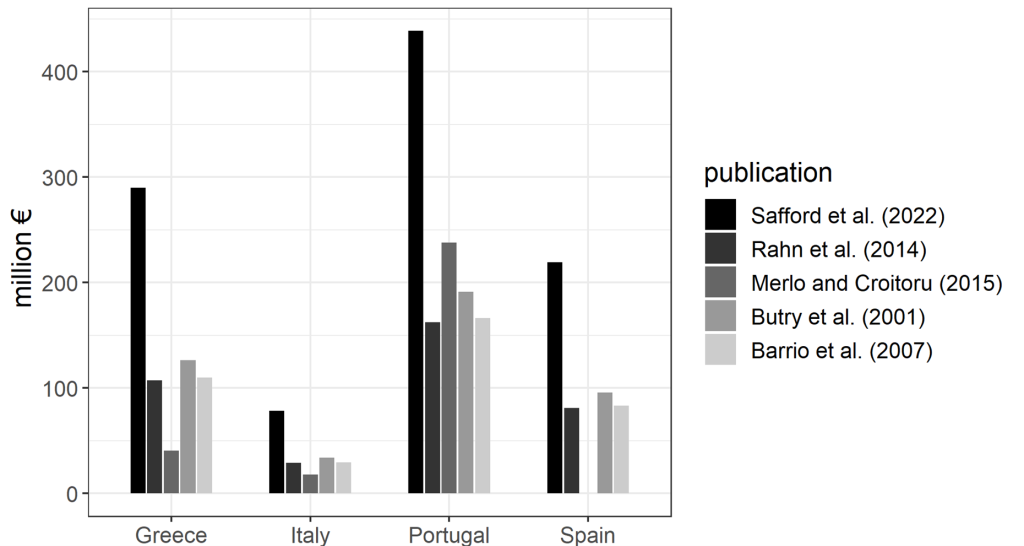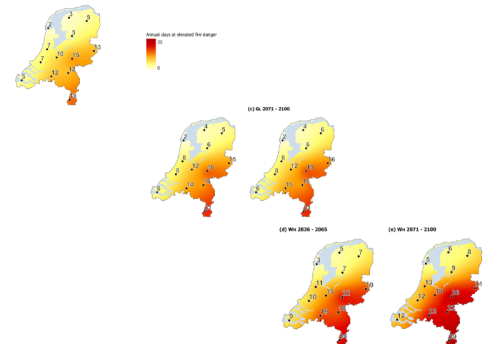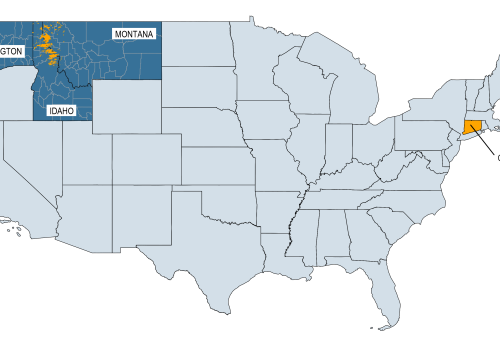
Written by Sarah Meier
Introduction
The Mediterranean area is the most fire-prone region within Europe with high wildfire incidence (San-Miguel-Ayanz et al., 2020). Not only do the Portugal, Spain, Italy, Greece, and France together account for about 85% of the total burned area in Europe, the Mediterranean area is also particularly vulnerable in that it is densely populated, characterised by a large wildland urban interface, and due to the species richness and a high proportion of endemism, it represents a biodiversity hotspot (Batllori et al., 2013; Myers et al., 2000). Notably, fire has played an integral role in shaping landscapes for centuries, performing beneficial ecosystem functions, and has been utilised by communities for agricultural practises. However, although societies and ecosystems are likely to adapt to near-normal conditions, evidence shows that is the particularly large wildfires that cause the majority of social, economic, and adverse environmental impacts (Bowman et al., 2017; Tedim et al., 2018).
In this blog post we present novel research quantifying and comparing wildfire risk probabilities across Southern European countries using Extreme Value Theory. Furthermore, using values from the existing literature we convert our estimates into monetary losses. The research is published in the journal Risk Analysis and has been co-authored by Sarah Meier, Eric Strobl, Robert J.R. Elliott, and Nicholas Kettridge at the University of Birmingham, UK.
This is an open access journal article accesible here.
Extreme Value Theory
As for most phenomena it is challenging and controversial to define extremes. One concept that has been used widely in many disciplines and industries such as structural engineering, reinsurance and finance is how to estimate the probability that, for example, a 100-year event occurs. Extreme Value Theory provides a tool to do exactly that – to model the probability of rare events based on historical records. This concept has been shown to be a suitable approach for wildfire size risk quantification (Hernandez et al., 2015; Holmes et al., 2008) and has been applied globally (Evin et al., 2018; Jiang & Zhuang, 2011; Keyser & Westerling, 2019). To the best of our knowledge, we are the first to use Extreme Value Theory to perform a cross-country quantification of wildfire risk for Mediterranean Europe.
The first step is to look at the data of interest and see whether the distribution of the events is suitable for this methodological approach. All kinds of measures such as height, life satisfaction, or memory skills are more or less normally distributed. Taking the example of height, this means, that first, most people are of average height, and second, there is a fairly similar number of people that are either taller or shorter than average. For these examples, extreme value theory would not be suitable. In our study, we use data on burned area provided by the European Forest Fire Information System and when we look at the distribution, we see that there are more rare or extreme events than one would expect under a normal distribution. This is called a heavy or fat-tailed distribution and means that the probability of extremely large wildfires is much higher than commonly perceived. So, extremes should not be that surprising after all. For phenomena with fat-tailed distributions, Extreme Value Theory is a useful analytical tool.
However, burned area is not the only factor we consider in our study. There are various assumptions that need to be fulfilled to use Extreme Value Theory and therefore we also model other factors that drive or affect the probability of wildfire occurrence such as the Fire Weather Index which gives an approximation of the meteorological conditions, population density, land cover type, and seasonality in a given geographical area. The interested reader who wants to delve deeper into the theoretical background of Extreme Value Theory is advised to the forthcoming journal article.
Burned Area Trends
First, we describe what we see in the data for our study period from 2006 to 2019. The single largest wildfire occurred in Portugal in October 2017 and burned more than 67’000 hectares. Greece experiences on average fewer but larger wildfires than the other countries i.e., half the fires burn more than 138 hectares. The country with the highest number of wildfires in our analysis is Italy where 233 fires occur in an average year.

Figure 1: Burned Area with indicated threshold choice (black dashed line) over our study period.
Figure 1 presents all the observations for each country separately. The data shows a slightly decreasing trend for burned area for all the countries except Portugal where no clear trend is visible. The black dashed line indicates the country-level thresholds derived from our modelling. The validated thresholds are 520 hectares for France, 1’550 hectares for Italy, 1’943 hectares for Greece, 2’600 hectares for Spain, and 4’900 hectares for Portugal. Wildfires above these thresholds are herein defined as extremes. Only considering those rare events, we observe decreasing trends for France, Italy, and Greece. No trend is evident for Spain, and we see an increasing trend in burned area for Portugal largely driven by the severe 2017 fire season.
Return Levels and Exceedance Probabilities
On way to quantify the risk of an extreme wildfire is in terms of return levels. Thereby, the return level in terms of burned area is exceeded with a probability of 1 divided by the time period of interest. For example, our modelling suggests a 10-year return level of about 50’000 hectares in Portugal. This means that the probability of a single wildfire burning more than 50’000 hectares is 1 divided by the time period of interest (i.e., 10 years) which in this case is 10%. In other words, 50’000 burned hectares is exceeded on average once every 10 years or one may call this a 10-year event.

Figure 2: Return-level plot for all countries. The horizontal axis shows the return period in years (on a logarithmic scale) and the vertical axis indicates the hectares burned. The dashed lines indicate confidence bands at the 95% level.
A graphical way to illustrate our findings is shown in Figure 2. It is called a return-level plot and it shows the return periods on the horizontal axis (note, that this axis is on a logarithmic scale which means that the optical distance between years is decreasing going from left to right) and the corresponding burned hectares on the vertical axis. We observe the highest risk of extremely large wildfires for all time periods for Portugal and the lowest for Italy. Comparing Greece and Spain, a higher burned area risk emerges for Spain for low return periods (approximately shorter than 3 years) and for larger return periods the return levels are higher for Greece.
Economic Valuation
In a second part of our paper, we transform the estimated burned area return levels into economic losses. We do this by multiplying our modelled expected burned hectares with the associated per hectare monetary losses estimated in the existing wildfire literature. To make monetary values comparable across currencies and years we adjust for inflation and express the losses in 2020 Euros. We emphasise that the utilised per hectare monetary losses in the five studies are highly dependent on the estimation method applied, the type of damage and losses included, and the specific situation of the scrutinised fire (season).
Two of the studies are carried out for Europe. The first estimates are derived from a comprehensive report for Mediterranean forests by Merlo & Croitoru and provides country specific per hectare cost of 1’228 Euros for Greece, 2’004 Euros for Italy, and 4’728 Euros for Portugal. The second economic impact estimate of 3’304 Euros per hectare we use is provided by Barrio et al. who implement an ecosystem service approach. As research on the economic impact of wildfires in Europe is limited, we additionally use three cost estimates from studies conducted in the United States. The Butry et al. case study assesses the 1998 wildfires in Florida and report costs that suggests a per hectare loss estimate of 3’801 Euros. Evaluating the 2003 wildfires in San Diego, Rahn et al. estimate that each burned area amounts to losses of 3’230 Euros. Finally, we add the estimate derived from a recent study evaluating the extraordinary 2020 wildfire season in California where the authors’ estimate is equivalent to 8’717 Euros (Safford et al., 2022).

Figure 3: 10-year return level economic loss estimates.
Coupling these per hectare loss estimates with our modelled burned area for the example of a 10-year event leads to the significant losses shown in Figure 3. For a 10-year return level extreme wildfire the expected losses amount to 41-290 million Euros for Greece, 18-78 million Euros for Italy, 162-439 million Euros for Portugal, and 81-219 million Euros for Spain.
Conclusion
In our study we assemble a high-quality homogenous geospatial data set for Mediterranean Europe and perform a cross-country risk analysis of extreme wildfires. Our results suggest the highest risk for extremely large wildfires in Portugal, followed by Greece, Spain, and Italy. We estimate the return levels for 5, 10, 20, and 50-year return period events and couple our outcomes with economic cost estimates. The robust estimation of extreme wildfire events underlying an evidence-based risk-assessment is arguably beneficial for various stakeholders, such as for governments, reinsurance institutions, and landowners providing support for information-based decision-making processes.
References
Barrio, M., Loureiro, M., & Chas, M. L. (2007). Aproximación a las pérdidas económicas ocasionadas a corto plazo por los incendios forestales en Galicia en 2006. Economía Agraria y Recursos Naturales, 7(14), 45–64.
Batllori, E., Parisien, M. A., Krawchuk, M. A., & Moritz, M. A. (2013). Climate change-induced shifts in fire for Mediterranean ecosystems. Global Ecology and Biogeography, 22(10), 1118–1129.
Bowman, D. M. J. S., Williamson, G. J., Abatzoglou, J. T., Kolden, C. A., Cochrane, M. A., & Smith, A. M. S. (2017). Human exposure and sensitivity to globally extreme wildfire events. Nature Ecology and Evolution, 1(3), 1–6.
Butry, D. T., Mercer, D. E., Prestemon, J. P., Pye, J. M., & Holmes, T. P. (2001). What Is the Price of Catastrophic Wildfire? Journal of Forestry, 99(11), 9–17.
Evin, G., Curt, T., & Eckert, N. (2018). Has fire policy decreased the return period of the largest wildfire events in France? A Bayesian assessment based on extreme value theory. Natural Hazards and Earth System Sciences, 18(10), 2641–2651.
Hernandez, C., Keribin, C., Drobinski, P., & Turquety, S. (2015). Statistical modelling of wildfire size and intensity: A step toward meteorological forecasting of summer extreme fire risk. Annales Geophysicae, 33(12), 1495–1506.
Holmes, T. P., Prestemon, J. P., & Abt, K. L. (2008). An Introduction to the Economics of Forest Disturbance. Springer.
Jiang, Y., & Zhuang, Q. (2011). Extreme value analysis of wildfires in Canadian boreal forest ecosystems. Canadian Journal of Forest Research, 41(9), 1836–1851.
Keyser, A. R., & Westerling, A. L. R. (2019). Predicting increasing high severity area burned for three forested regions in the western United States using extreme value theory. Forest Ecology and Management, 432, 694–706.
Merlo, M., & Croitoru, L. (2005). Valuing Mediterranean Forests – Towards Total Economic Value. In Towards Total Economic Value. CABI Publishing.
Myers, N., Mittermeier, R. A., Mittermeier, C. G., da Fonseca, G. A. B., & Kent, J. (2000). Biodiversity hotspots for conservation priorities. Nature, 403, 853–858.
Rahn, M., Hale, K., Brown, C., & Edwards, T. (2014). Economic Impacts of Wildfires: 2003 San Diego Wildfires in Retrospect. San Diego State University.
Safford, H. D., Paulson, A. K., Steel, Z. L., Young, D. J. N., & Wayman, R. B. (2022). The 2020 California fire season: A year like no other, a return to the past or a harbinger of the future? Global Ecology and Biogeography, January, 1–21.
San-Miguel-Ayanz, J., Durrant, T., Boca, R., Malanti, P., Libertà, G., Artés-Vivancos, T., Oom, D., Branco, A., de Rigo, D., Ferrari, D., Pfeiffer, H., Grecchi, R., Nuijten, D., & Leray, T. (2020). Forest Fires in Europe, Middle East and North Africa 2019.
Tedim, F. T., Leone, V., Amraoui, M., Bouillon, C., Coughlan, M., Delogu, G., Fernandes, P., Ferreira, C., McCaffrey, S., McGee, T., Parente, J., Paton, D., Pereira, M., Ribeiro, L., Viegas, D., & Xanthopoulos, G. (2018). Defining Extreme Wildfire Events: Difficulties, Challenges, and Impacts. Fire, 1(1), 9.




Leave a Reply